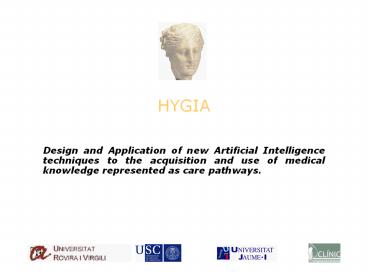HYGIA - PowerPoint PPT Presentation
1 / 13
Title: HYGIA
1
HYGIA
- Design and Application of new Artificial
Intelligence techniques to the acquisition and
use of medical knowledge represented as care
pathways.
2
Outline
- The use of Intelligent Systems in the processes
of acquiring, formalizing, adapting, using and
assessing knowledge models that describe Care
Pathways. - The HYGIA Project
- HYGIA Groups and Members
- General Objectives
- Organization of the Project
- Subproject 1 Santiago de Compostela University
- Subproject 2 Jaume I University
- Subproject 3 Rovira i Virgili University
- Subproject 4 Clinical Hospital of Barcelona
- Integration of Subprojects
- Conclusions
3
The HYGIA Project
- Funded by Ministerio de Educación y Ciencia
(Spain) - Plan Nacional de IDI (2004-2007)
- Code TIN2006-15453-C04
- Start date October 1st 2006
- End data September 30th 2009
- Webpage www.etse.urv.es/drianyo/TIN2006-15453/
4
Groups and Members
1. (David Riaño) 2. (María Taboada) 3. (Mar
Marcos) 4. (Albert Alonso)
5
Terminology
- Clinical Practice Guideline (CPG) standard set
of textual pathology-oriented recommendations for
the clinical handling of patients with a certain
pathology. - Electronic Clinical Practice Guideline
computerized version of a CPG, represented with a
formal language. - Protocol specific adaptation of a CPG that
includes precise indications on the
pathology-oriented health care actuations to
follow under a concrete situation. - Electronic Protocol (EP) computerized version of
a protocol, represented with a formal language. - Care Pathway (CP) operative version of a CPG
that details the steps to follow for the care of
a disease in a certain segment of patients
(patient-oriented) and in a concrete healthcare
context (health service oriented).
6
General Objectives
- Design and Implement a set of tools to automate,
as far as possible, the acquisition of knowledge
from textual CPGs. - Propose a methodological framework to develop
electronic protocols from electronic CPGs. - Propose a methodological framework to elaborate
CPs from electronic protocols and other
additional resources, as hospital databases
containing information about patient treatments. - Construct and use new inductive learning
algorithms to generate health care knowledge from
hospital databases with the use of ontologies
that provide the semantic component of the
medical domain of the guidelines. - Application of these knowledge structures (CPs)
to support decision making and quality control by
means of a multi-agent system that interprets the
knowledge in the context it is used. - Identify and assess the adherence of health care
professionals to comorbid CPs in a program of
chronic patients.
7
Project Organization
- Subproject 1 (USC)
- textual analysis
- ontology management
- Subproject 2 (UJI)
- knowledge acquisition
- knowledge engineering
- Subproject 3 (URV)
- knowledge induction from databases
- tools for knowledge exploitation
- Subproject 4 (HCB)
- knowledge validation
- knowledge exploitation
8
Subproject 1 topics and technologies
- (Semi)-automatic Acquisition of Knowledge from
textual CPGs - Natural language processing to recognize words,
to make syntactic analyses and to divide phrases
into words (tokens). - Information extraction to extract pre-specified
types of information from the text of the CPG. - All the processes supported by medical thesauri
as the Medical Unified Language System (UMLS) . - Main phases
- extract a domain ontology from textual documents
- (semi)-automatically acquire the knowledge of
CPGs - represent it in a language oriented to describe
electronic CPGs.
9
Subproject 2 topics and technologies
- Propose a methodological frame for the
transformation of eCPGs in protocols and the
combination of protocols in CPs. - Knowledge Engineering knowledge representation
and acquisition - Software Engineering eCPGs and protocols are
similar to programs - Formal verification of eCPG directives in the
electronic protocols. - Main phases
- determine sort of eCPG directives to verify in
the e-protocols. - propose an experience-based methodology to obtain
e-protocols - formalization of patient and institution models
to construct CPs. - propose a methodology to combine and adapt
e-protocols
10
Subproject 3 topics and technologies
TREATMENT MODEL
MAS
- Develop algorithms to obtain health care
procedural knowledge from hospital databases - Data and Knowledge modelling and representation
- Inductive Learning
- Design and implement a software tool to apply
health care procedural knowledge - Multi-agent systems
- Software Engineering for MAS
- Decision support systems
- Quality control to measure adhesion indicators
- Main phases
- Propose a data and a knowledge model to represent
health care procedures - Develop inductive learning algorithms to obtain
procedural knowledge form procedural data - Design and implement a Multi-agent system to make
this knowledge actionable - Adapt the Multi-agent System to incorporate the
screening of adhesion indicators
11
Subproject 4 topics and technologies
- Provide recognized experience in health care of
multi-pathology patients to validate and
supervise the intermediate and final CPGs, eCPGs,
protocols, e-protocols, and CPs - CPGs and protocols on obstructive pulmonary
disease, cardiac insufficiency and diabetes - Patient models and institution models
- Adhesion indicators
- Provide data of the historical database of the
hospital - Data bases and information systems
- Data pre-processing and data mining
- Test intermediate and final software in a program
of chronic patients
12
The Integration of Subprojects
13
Conclusions
- The project aims at
- Establishing a framework on the problem of
managing procedural knowledge in medicine. - Fostering the interaction of 4 groups with past
experience in alternative approaches to the
problem. - Integrating alternative Artificial Intelligence
technologies in the setting of this problem. - Converging in a national reference in the field.
- Attracting the interest of and incorporating the
collaboration of groups with similar interests. - Disseminating the achievements of the group.
- Extending the collaboration to new projects.
- Trespassing the threshold of laboratory
applications and pave a road to the real
application of the results. - Interested people, groups, or associations,
please contact David Riaño at david.riano_at_urv.net





















